
This page was not written with artificial intelligence (AI), but [technically speaking] it could have been.
This page will show you how to get the most out of AI, while still retaining the necessary human components required for the best content creation.
Because while leveraging AI at the foundational level of content strategy and content development is the future for all organizations across every industry, worldwide (seriously); it’s not going to replace your team or all of your tasks because the human element of content is still necessary to reach your target personas.
This page will teach you how to use AI to enhance your content team’s effectiveness.
What is AI?
Artificial Intelligence (AI) simulates human intelligence using machines and computer systems. AI systems work by analyzing and ingesting large amounts of data to develop algorithms and models. The technology aims to create machines that think and learn like humans, automating tasks that traditionally rely on human input. Artificial intelligence has a variety of uses, such as natural language processing, speech recognition, and machine vision.
Where is AI Used Today?
On a daily basis, you probably encounter AI in several forms. Personalized recommendations on Netflix, Amazon, and Spotify use AI algorithms tailored to your preferences and past behaviors. If you’ve ever used Siri or Amazon’s Alexa, you’ve used AI. These AI systems respond to voice commands and can set alarms, play music, and tell you the weather.
Other typical applications of AI include:
- Healthcare: large amounts of medical data are analyzed to identify patterns and help diagnose diseases and develop treatment plans. Chatbots and online virtual health assistants can help patients find medical information, schedule appointments, and assist with billing.
- Education: automated grading, assess students and help teach based on their needs, help educators develop engaging materials.
- Finance: used in personal finance apps such as Turbo Tax, provide financial advice, help users buy a home.
- Law: sift through documents and describe data to predict outcomes.
- Entertainment and media: used for targeted advertising, distribution, creating scripts, and proofreading.
- Software coding and IT: produces code to build applications and help automate IT tasks such as data entry, customer service, and predictive maintenance.
- Security: detects suspicious activities more quickly than humans.
- Transportation: drives self-operating vehicles, analyzes traffic in real-time and optimizes traffic flow and driving patterns, predicts flight delays, and makes ocean shipping safer and more efficient.
The Intersection of Content and AI
AI content creation uses tools powered by artificial intelligence to create and share content. You can use AI to assist with writing and proofreading blog posts, social media captions, marketing emails, recipes, and creating art. For anything that requires creativity, AI can assist.
Integrating AI with your content strategy can make your job more efficient and enhance the content you create.
- AI can be helpful in the initial stages of content creation by producing outlines and captions for your posts.
- Save time proofreading, formatting, and rewriting with AI.
- Artificial intelligence can assist with personalizing your content based on user preferences and behaviors, tailoring messages and delivery.
- AI also has the power to make your content more accessible to larger audiences, adding captions and subtitles to your videos or converting your text to speech.
- Audio description AI can develop audio descriptions of images. Text simplification can suggest changes to make your text easier to understand for those with learning disabilities or who are learning a new language.
While AI can be your next content-creating BFF, it’s important always to edit and proof everything AI produces.
While AI is a remarkable technological advancement, it isn’t perfect and can still make mistakes. Chat GPT even has a disclaimer that it may “produce inaccurate information about people, places, or facts.”
Editing AI-produced outputs to align with your brand’s tone and style is a must! This will help you stay consistent and on-brand and ensure your writing reflects your brand, not an algorithm.
The Benefits of AI in Content Strategy
In 2022, the top uses for AI in content marketing were advertising (58%), data analytics (57%), and personalization (49%). Using AI in your content strategy optimizes the process of creating and producing content.
Using AI while creating content makes the process more efficient by automating routine tasks, giving you time to focus on more complex projects.
AI programs can be trained to execute repetitive and tedious jobs, like data entry and analysis, much quicker than humans. And since AI algorithms are trainable and learn from experience, its performance will only improve with time.
Personalization is an essential piece of the content strategy puzzle, but it can take a lot of time and energy to create relevant and engaging content for your users. AI can help collect and analyze large amounts of data from your website, CRM, social media, and email sources. Analyzing user data gives content marketers a better picture of their audience’s preferences, behaviors, needs, and struggles. This allows for segmenting contact lists based on interests, location, and goals.
Let AI assist with finding the best time to publish your content on various channels and track user engagement in real time. When users receive relevant and engaging content, you build trust and loyalty with your customers = win!
One of AI’s greatest features is that it can significantly reduce human error.
Automating tasks that require attention to detail and accuracy, such as data entry, analysis, and quality control, can improve the quality and consistency of your tasks.
Use AI to ensure content is accurate and engaging in the following ways:
- Fact-checking your data: AI can quickly cross-reference large amounts of data to ensure your content is factually correct, preventing misinformation from being published.
- Language translation: AI can translate complex sentences and industry-specific jargon into different languages.
- Optimize content: AI algorithms analyze user behavior to optimize engagement and the impact of your content. AI can suggest specific keywords and images that improve the chances of your content gaining traction with your audience.
- Detecting plagiarism: AI technology can quickly scan content and identify instances of plagiarism, ensuring your content is original.
- Sentiment Analysis: AI can detect the tone and sentiment of your content and determine how it may be perceived by readers and give suggestions on how to adjust the content.
Another benefit of using AI in content creation is that it’s highly scalable, allowing marketers to adapt to users' changing needs.
AI can keep up as your contact list gets larger and content production grows. This allows businesses and marketers alike to keep up with their competition and achieve their goals despite increasing demand.
How to Use AI in Content Development
So how should you get started with AI in your content development plan?
Just dive in!
Content Ideas
One of the best ways to use ChatGPT and other generative AI is for ideation. Ask it some questions, get some ideas about what’s out there, and use it like another team member – bouncing off ideas and seeing what resonates.
ChatGPT prompt examples:
- Provide 10 blog topic titles about [topic]
- Generate a list of ten long-tail keywords related to [topic]
Search Engine Optimization
Yep. AI can help you with search, too! From simple – like asking ChatGPT to Generate a list of ten long-tail keywords related to your topic of interest, to complex – like “analyze this website page and tell me how my content compares.”
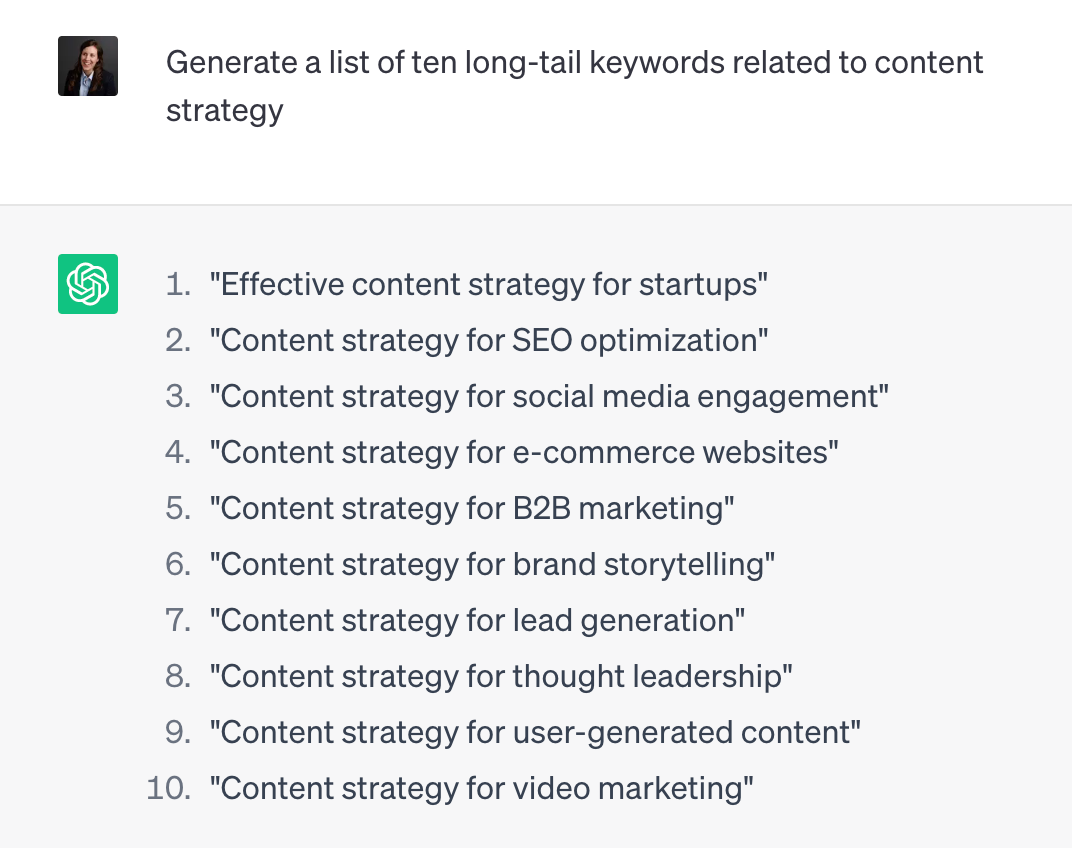
(Image source: ChatGPT)
If you have access to SurferSEO or other more robust platforms, you can compare pages based on a single keyword of interest and determine what changes you need to make to boost your performance in search.
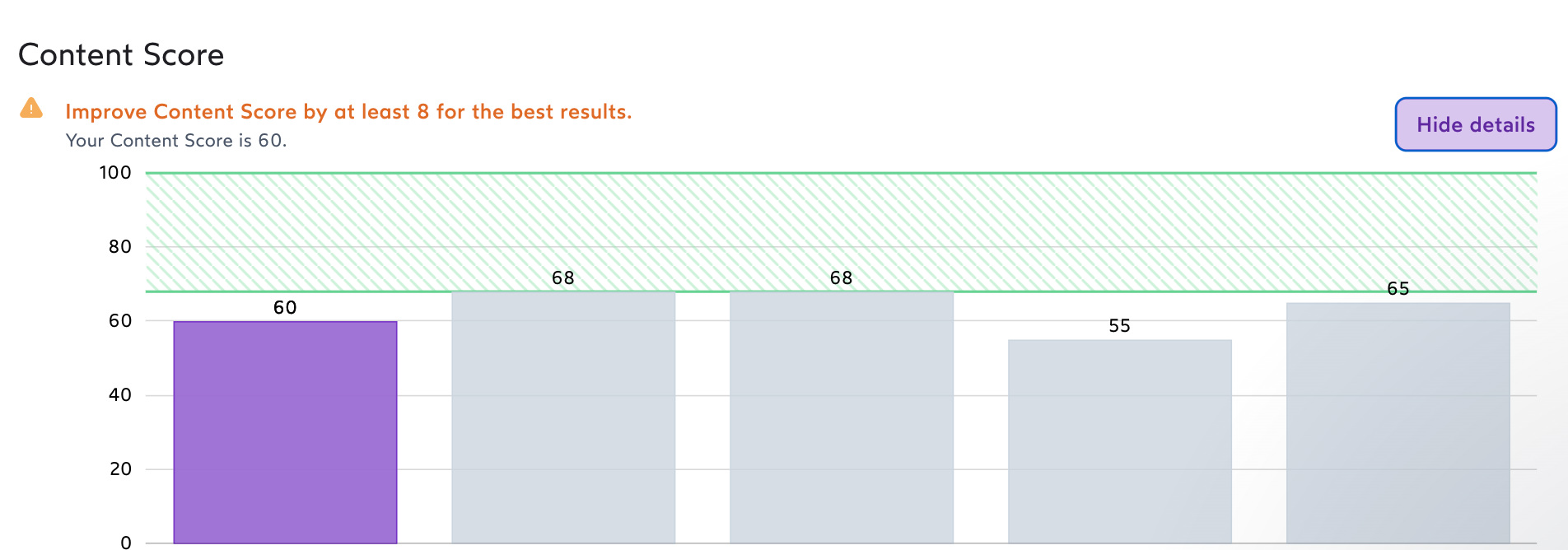
(Image source: SurferSEO)
Outlines
Use well-written prompts to help you develop a robust blog or website page outline taking into account bext practices and the current search landscape.
Some examples:
- Good: Generate a blog outline for a blog post about [topic]
- Better: Write a blog outline on the [ TOPIC ] for [ AUDIENCE ].
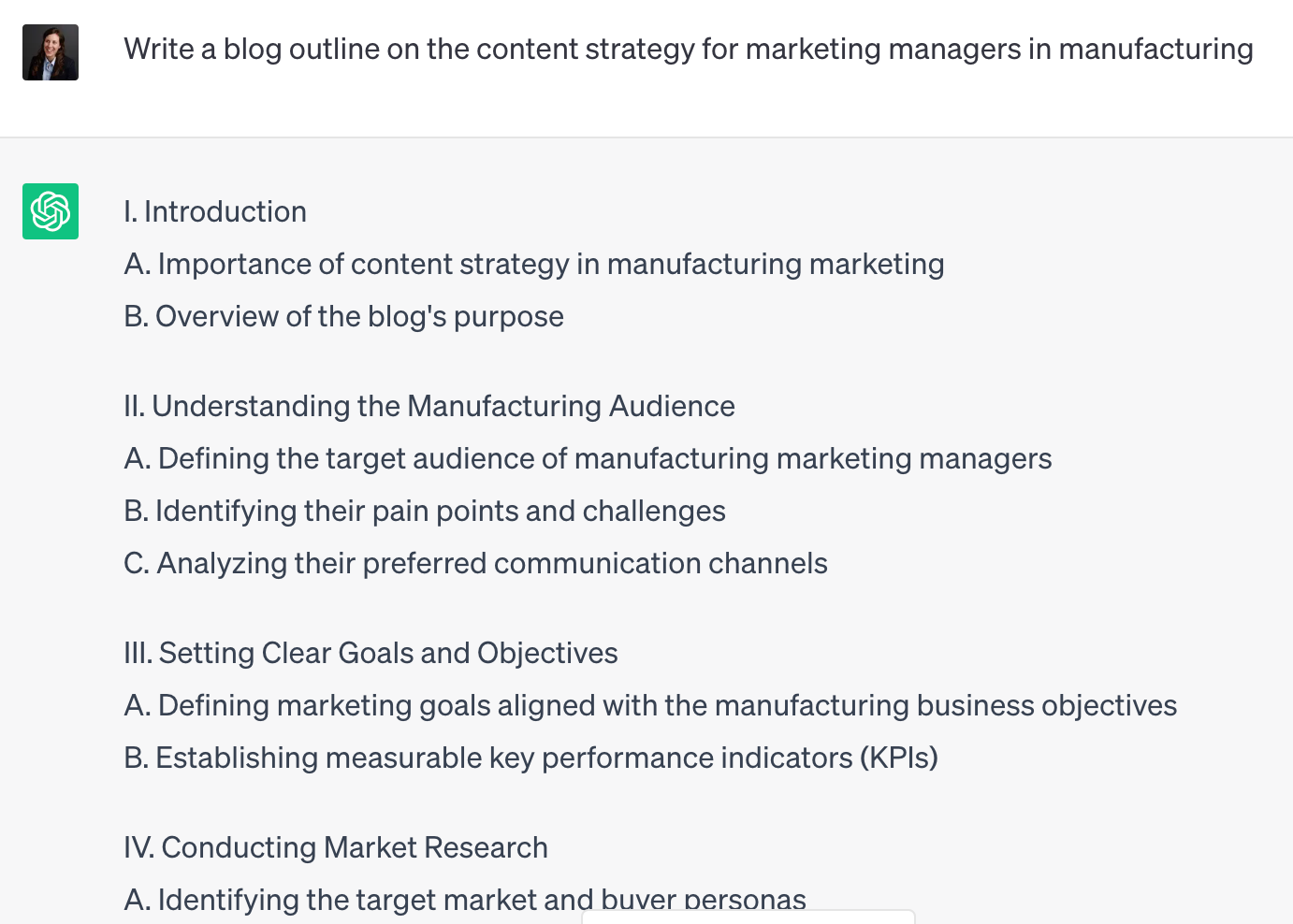
[ ... ]
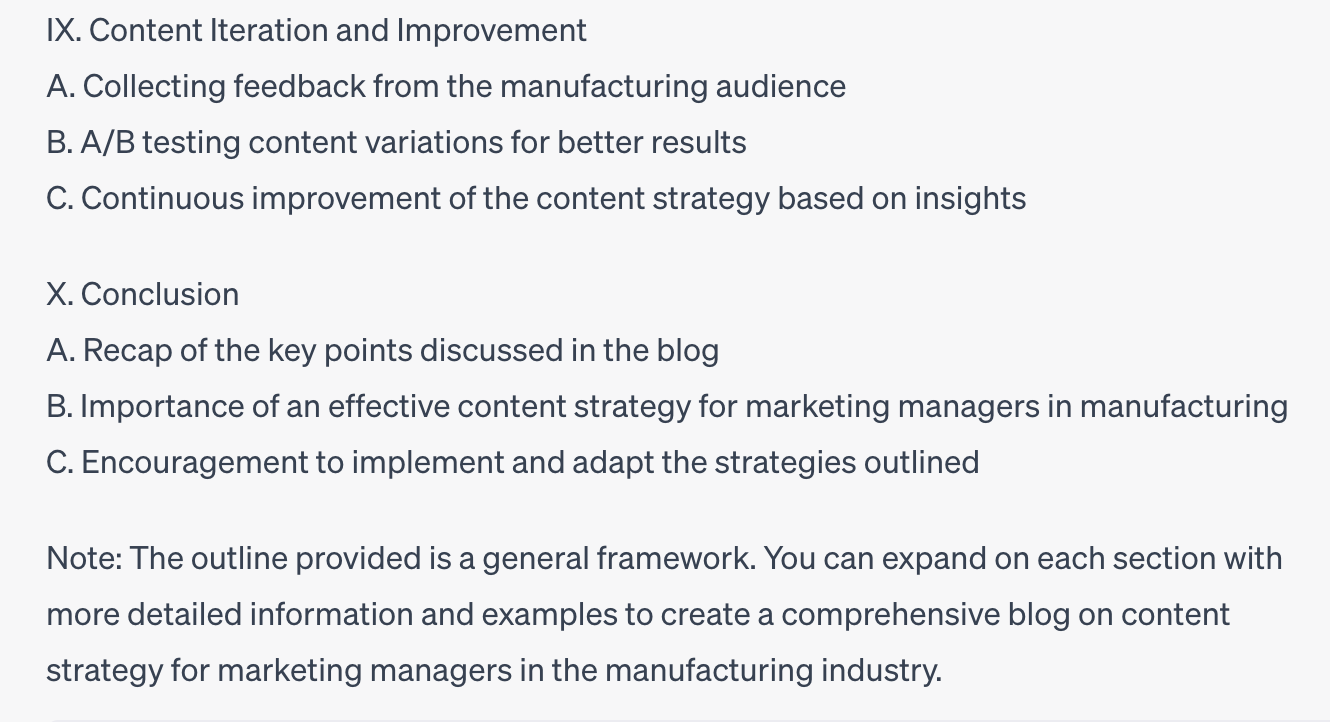
(Image source: ChatGPT)
Other ways to leverage tools like ChatGPT for blog outline writing:
- Make a list of the top five common [ TOPIC ] mistakes and how to avoid them
- Create a step-by-step tutorial on how to [topic]
- Create a blog outline focused on the advantages of [ TOPIC ]
- Write a blog post outline on the significance of [ TOPIC ] to society
Content Writing
As a writer, I would be the first to say do not use AI to write your content because it’s just not going to be good enough. It cannot tell stories the way a writer can or convey emotion and it also is unable to capture the written word the way humans do. But, that doesn’t mean it can’t be helpful!
- Use it like a thesaurus to add more depth to your sentences
- When you are stuck on a sentence, ask AI to rewrite it for clarity or interest
- Ask it to summarize your article for a conclusion
- Ask it to come up with a clever opening hook or calls-to-action to infuse throughout
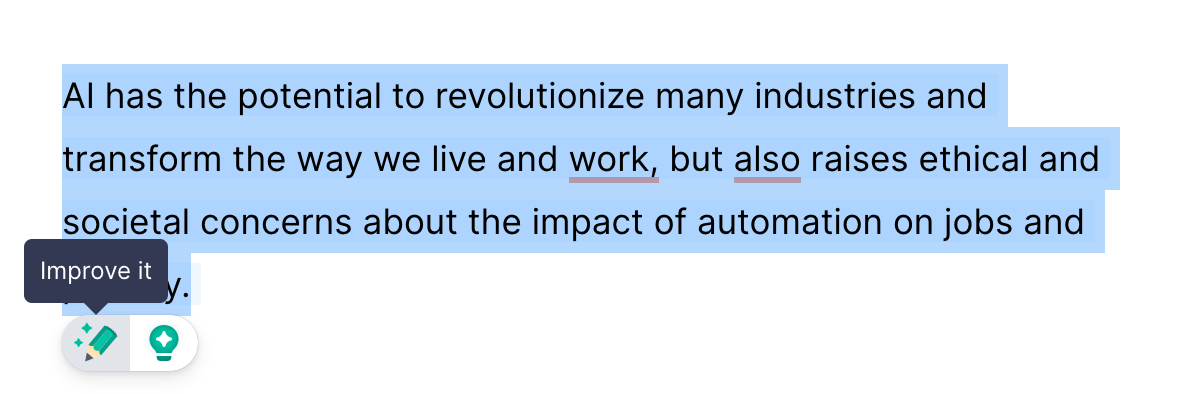
(Image source: Jasper.ai)
How to Use AI in Content Strategy
There are so many AI-powered tools that can help marketing managers. From research topics ideas and developing outlines and SEO-based research, to execution of creative assets and distribution and amplification – AI can help streamline and automate content strategy processes.
Here is a short list of AI-powered tools that you may want to consider adding to your A-team.
ChatGPT-3/4: Content generator for text, images, and other relevant content
ChatSpot: HubSpot’s ChatGPT-powered AI that integrates into page writing and content development.
Jasper.ai: Write, rewrite, brainstorm and research with the new program features.
Moz’s Keyword Explorer: AI-powered SEO research tool
SEMrush: SEO analysis tool powered by AI.
SurferSEO: SEO analysis tool powered by AI that also integrates with Jasper for content outlines and writing.
Flick AI offers a social media assistant designed to streamline the brainstorming, writing, and planning process for social media content.
GrowthBar uses GPT-3 AI to automate content generation. It can suggest keywords, exact word count, links, images, and more.
Smartwriter.ai assists in automating your email outreach. This AI tool generates a personalized email, including a personal subject line to pique the interest of customers.
Grammarly It performs basic functions like grammar and spell checks but goes a step further by rewriting sentences.
Seventh Sense is an AI email marketing campaign tool that ensures your emails get delivered at the right time for each customer.
DeepL is a powerful AI tool that translates documents and files into several popular languages of your choosing.
Smartly.io is an AI-based ad marketing tool that lets teams plan, test, and launch only the best-performing ads to their target audience.
Zapier is used for marketing automation between thousands of different systems, saving you time, promoting efficiency, and increasing cost savings.
Chatfuel helps businesses build simple chatbots and FAQ references with ease.
PhotoRoom uses AI and machine learning to identify the subject of a portrait and separate it from the background.
Influencity is powered by AI to help brands assess and contact marketing influencers, collaborate on campaigns and then track overall effectiveness.
Here’s a quick-start guide to get you started:
- Identify your content goals and objectives
- Determine how AI tools can help with specific tasks or requirements
- Create and optimize content assets
- Collect and organize data
- Analyze data and compile insights and opportunities for improvement
As you work through your strategic content planning and development, find ways to integrate successes with AI into your processes so you can continue to hone in on new efficiencies.
Responsible Use of AI in Content Development and Strategy
While the benefits of using AI in content creation are undeniable, there are considerations you should take while using it. AI is still a new and developing technology; questions about its ethics, bias, and transparency are things to consider to ensure you’re using AI responsibly.
When using AI in your content strategy, be aware of what data is being analyzed and where it comes from.
Always ensure your users' privacy and data rights are respected, and let your audience know how you use their data to deliver personalized content. Personal data should be protected and used only for the intended purpose.
Like humans, AI does not come without bias.
AI learns by processing and analyzing large amounts of data to identify patterns and make predictions, and sometimes this data can be biased. As diversity and inclusion is a growing focus for many companies and consumers, paying attention to AI-produced content and mitigating bias is important, for bias can perpetuate discrimination and social inequalities against certain groups.
Machine learning bias, or algorithm bias, happens when the data given to teach the algorithm reflects human biases.
Data bias is another form of bias that can impact AI. It happens when the data used to train the AI isn’t representative of the population it’s intended to serve.
Biases in AI are not intentional, and it isn’t easy to detect them until they have been programmed into the software. Bias can be introduced at different stages in AI development, such as data collection or algorithm design. Therefore, it’s crucial to design and train AI algorithms with diverse data that is representative of the population as a whole to prevent bias.
Being transparent with your audience about the use of AI is important when publishing accurate and trustworthy content. Being transparent with your audience means you inform them about the AI system being used, how it was developed, and how it operates. Including a disclaimer that AI technology was used to assist with creating your content is a simple way to let your readers know artificial intelligence was used.
With new forms of AI rapidly developing, AI oversight is becoming an important topic. Data is constantly being collected, stored, and used to train AI. This creates the question of who is accountable for overseeing the technology and ensuring user data is used ethically and responsibly.
AI governance is the presence of a legal framework to make sure machine learning (ML) technologies are thoroughly researched and developed to ensure accuracy, safety, and fairness. AI governance bridges the gap between accountability and ethics in these new technologies. As AI rapidly spreads into sectors such as healthcare and transportation, the need for AI governance grows.
AI governance topics include:
- Appropriate uses for the technology
- What legal and instructional entities need to be involved
- Personal data use
- Morality and ethics of the technology.
AI governance will ensure AI systems are transparent, explainable, non-discriminatory, and used to benefit humanity.
Discussing who oversees AI leads to the next question; who owns AI and its trademarks?
AI ownership discussions include who owns the intellectual property rights to AI systems. While the answer can be simple in some instances, such as an AI system being developed by a single company that owns the rights to the systems, this is not always the case. AI ownership can be a complex line to draw in situations where the system was developed using multiple software by multiple parties.
Trademark licensing enables owners to achieve rewards by allowing other parties to use their marks while protecting the service's names, logos, and other identifying features. And the lines get blurry when AI generates such logos and products.
While AI has several benefits, it also brings new questions and challenges.
Challenges and Limitations of AI in Content Strategy
While we’ve discussed the benefits of using AI and considerations such as ethics and responsibility, artificial intelligence does not come without challenges and limitations. Data quality, integration with existing systems, technical expertise, and cost are all considerable challenges with this rapidly developing technology.
There are several steps businesses can take to ensure their AI systems are properly integrated with existing technologies:
- Develop a clear strategy: Define business objectives and stakeholders, outline the required resources to successfully reach these objectives, and identify key milestones and metrics for measuring success.
- Ensure data quality and availability: Ensure all data used to train AI systems use accurate and unbiased data to allow for an accurate and efficient AI system.
- Educate and upskill employees: developing AI requires trained employees on different topics, such as data management, machine learning, and model development.
- Don’t ignore organizational obstacles: AI is changing the working world, creating uncertainty among employees. Demonstrate the benefits AI provides to your organization and its business goals and keep employees involved in the decision-making process to allow feedback and suggestions.
- Follow legal and ethical standards: Integrating your AI with existing systems should always abide by legal and ethical standards. Your technologies should be transparent, explainable, and ethical to build trust with stakeholders.
While you don’t have to be an AI expert to use the technology, you should be aware of its capabilities and limitations.
Need help developing an AI policy? Let us know, we can help!
Can AI help boost your website performance?
Benchmark where you are now and how it compares to others!








